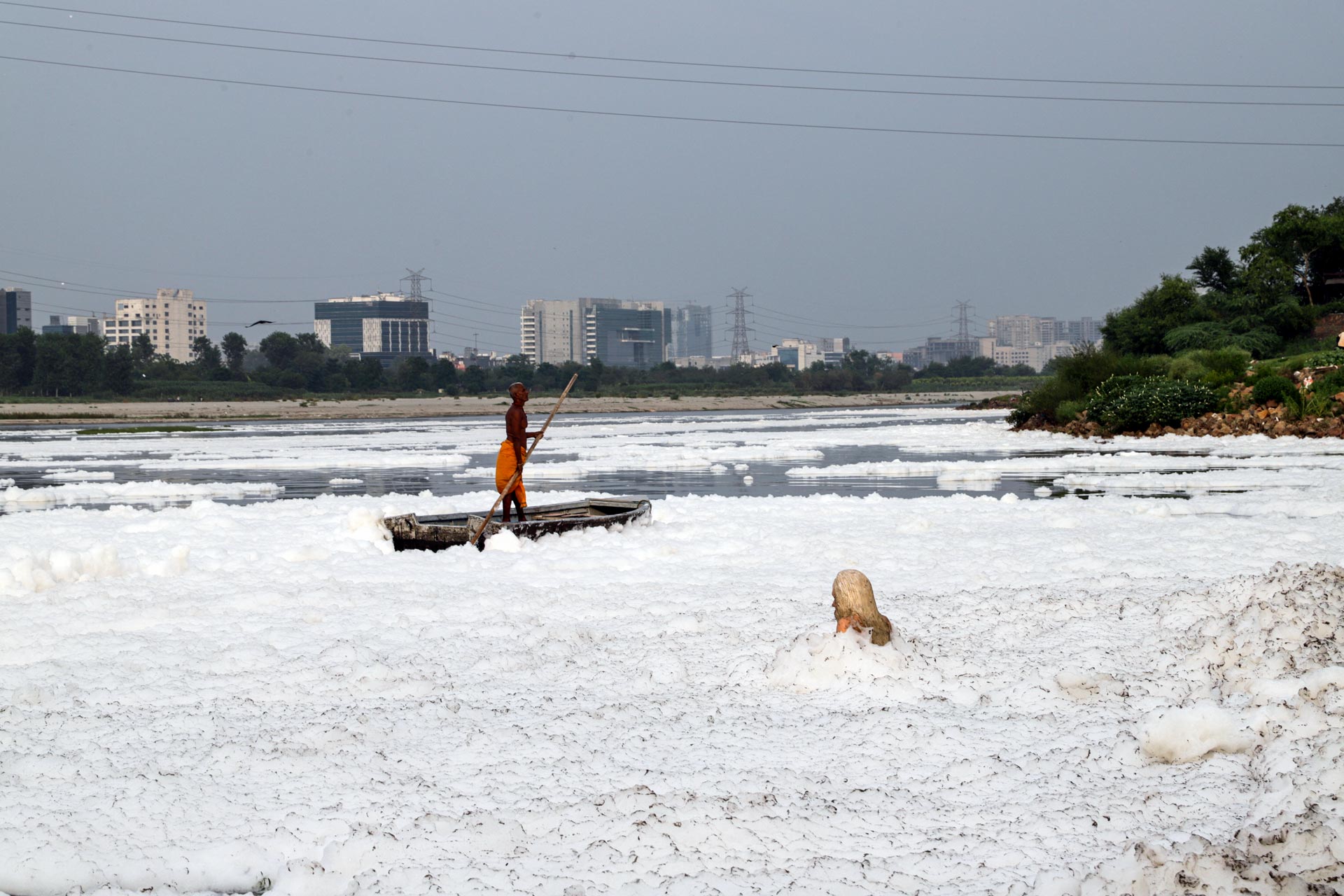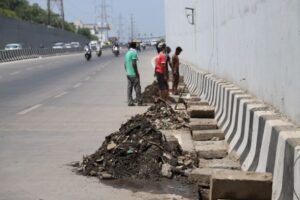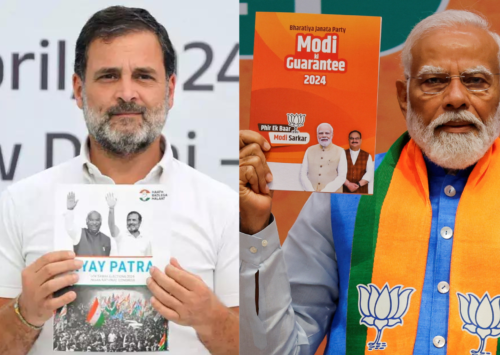Major health risks due to untreated sewage disposal

According to analysts, 80 pc of India’s surface water is unfit for consumption and everyday over 40 million litres of wastewater enters its natural water bodies (MIG photos/Aman Kanojiya)
India produces close to two million tonnes of faecal waste every day and the urban areas alone, accounting for just over a third of the total population of the country, generate over 62,000 million litres of sewage daily. Of this, over 60 pc or close to 38,000 million litres is dumped untreated, most of it in rivers, lakes and other water bodies. Though there is no reliable data on the situation in rural India, the overall picture about how India has failed to manage its domestic waste can raise quite a stink.
In 2019, highlighting the urgency of tackling the problem, the National Green Tribunal held that environment degradation severely affects human health requiring immediate attention and cannot be dealt with by authorities at leisure. NGT went on to express serious concern over the lack of compliance of environmental norms, leading to several deaths, besides causing serious damage to the country’s air, water and soil.
India’s capacity to treat wastewater is about a third of what is needed to be able to treat it properly and as a result, over two-thirds of sewage is simply dumped in the open, polluting not just the rivers and lakes, but also soil and groundwater as waste leaches deep into the ground. The real situation is even more alarming as of the 816 sewage treatment plants, only 522 are operational, meaning less than 19,000 million litres per day of sewage gets treated. Sunita Narain, director of Centre for Science & Environment (CSE) says that 80 pc of water supplied to each household leaves the home as sewage. “Since cities do not have any accounts of the sewage they generate, they cannot plan and do not have the capacity to treat all the sewage they generate. This has the gravest implications for rivers where the faecal sludge is dumped. We are a generation of lost rivers. How many will we lose before we remember that unless sewage is managed, the river-cleaning operations will not work?” asks Narain.
Data released by the CSE paints an even darker picture of the reality. The CSE analysis points out that the amount of sewage generated in 2009 was 38,255 million litres daily (MLD), while India’s capacity to treat was only 11,788 MLD, which was a mere 30 pc of the total waste generated. However, the actual sewage treated was even less at 8,251 MLD, which was about 22 pc.
Lower treatment standards
Not just that India lacks adequate treatment capacity for its sewage, but it also mandated lower norms for quality of treatment, leading to release of large volumes of water which have been treated but not enough to make the water safe for human or animal consumption. In 2019, the NGT passed a stricture against the government and asked it to tighten the norms and bring them at par with the international norms.

According to Census 2011, only 33 pc of houses are connected to sewer systems (MIG photos/Aman Kanojiya)
Reports highlight alarming methods of sewage disposal. According to Census 2011, only 33 pc of houses are connected to sewer systems, only around 38 pc use septic tanks. These septic tanks do not treat waste and have to be emptied periodically. The report points out that entrepreneurs who service septic tanks, pump out the sludge from the tanks and empty it into drains, fields—just about anywhere.
As a result, analysts say that 80 pc of India’s surface water is unfit for consumption and everyday over 40 million litres of wastewater enters its natural water bodies. Eventually, contaminated water also enters the groundwater. Because of this, proper waste management and sewage pollution cannot occur, upsetting the irrigation system. The crops are not able to grow because of the infectious bacteria and disease in the water. Because of the poor infrastructure and absence of sewage control, 38 million Indians suffer from waterborne diseases like typhoid, cholera and hepatitis every year. Over the last decade, the frequency of these illnesses remained at the same level.
Huge economic losses due to poor sanitation
According to the World Economic Forum, water pollution is responsible for a 9 pc drop in agricultural revenues and a 16 pc drop in farming yields. A report by the World Bank says that pollution lowers economic growth in downstream areas, reducing GDP growth in these regions by up to a third. In middle-income countries like India where water pollution is a bigger problem, the impact increases to a loss of almost half of GDP growth.
The cost of environmental degradation in India is estimated to be INR 3.75 trillion (USD 80 billion) a year and the health costs linked to water pollution are estimated to be upto INR 610 billion (USD 9 billion) a year, mainly due to deaths from diarrhea and morbidity of children under five years of age. Problems with availability of proper water sanitation cause up to 400,000 lives per year in the country, over 25 pc of the global casualties.
The predictions for the future are even more dire than the current state. Estimates say that by 2030, up to 40 pc of Indian population, or 700 million persons, will lack access to clean water. Already, it is becoming more difficult for people to get adequate water for their needs due to disappearing water resources. For instance, between 2001-2012, Hyderabad lost 3,245 hectares of lakes and ground water level falls by 9 feet (2.7 m) a year in south Delhi, due to incessant pumping of groundwater.
With nearly 600 million Indians facing high-to-extreme water stress – where more than 40 pc of the annually available surface water is used every year, the situation is likely to worsen as the demand for water will exceed the supply by 2050, cites the Composite Water Management Index (CWMI) report, the government’s first comprehensive collection of nationwide water data.
Booming population, shrinking resources
The main reasons behind India’s dramatic water shortage are rather well known and have been so for years, if not decades. The first is the growth in population. In the seven decades since independence, India’s population has grown four-fold, while the natural water resources have remained the same or declined due to a variety of reasons. This means that even if all other factors were absent, India’s per capita water availability would have declined by nearly 75 pc in the 70-odd years.
One of the biggest reasons is the huge increase in the use of water for farming, not because Indian farmers are producing more, but mainly because of the wrong choice of crops being cultivated even in the areas where the climatic conditions are anything but suitable. In order to increase their incomes, farmers all over have adopted water guzzling cash crops like sugarcane and freely use groundwater, aided by the fact that farmers don’t pay for water and in most states, even the electricity used to operate the pumps that draw out billions of litres of groundwater, is offered free by governments in many Indian states.
Industry is another key reason behind the current water shortage. Even though pollution treatment, water harvesting and recycling is mandatory for the industry, this rule is followed on paper only, leading to immense pollution of the rivers, lakes as well as the groundwater sources. Farming, too, contributes to the pollution through excessive use of pesticides and fertilisers by farmers keen to make the most with their harvests.
The impact of absence of pricing of groundwater is also felt in urban areas where every well-to-do or even middle class household has access to borewells that draw water from deep under the earth, often stretching to more than 100 m deep. In the absence of any regulation of groundwater, not only households but also commercial establishments like hotels, offices and restaurants dip into the free water that they suck out of the earth each day. The impact of this free for all is seen regularly in a place like New Delhi where the groundwater table in the well-to-do parts of the city has collapsed to 80 m below the surface.
Globally, India is the biggest user of groundwater. It extracts more groundwater than China and the US, the next two biggest pullers of groundwater, combined. Groundwater meets more than half of total requirement of clean water in the country, with the consumption only increasing. About 89 pc of groundwater extracted in India is used for irrigation. Household use comes second with 9 pc share followed by industries that use only two pc of it. Overall, 50 pc of urban water requirement and 85 pc of rural domestic water need are fulfilled by groundwater. According to report by Central Ground Water Board (CGWB), the groundwater level dropped by 61 pc between 2007 and 2017. Not just this, use of availability to fetch groundwater by only some people, ones with access to the right machines, such as electric motors to fetch underground water, has also led to huge disparities in fair availability of water.









